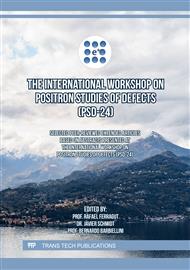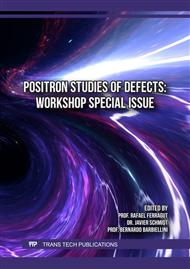[1]
S. Hussain, I. Mubeen, N. Ullah, S.S. Shah, B. A. Khan, M. Zahoor, R. Ullah, F. A. Khan, M. A. Sultan, Modern diagnostic imaging technique applications and risk factors in the medical field: A Review, BioMed Res. Int. 2022 (2022) 5164970.
DOI: 10.1155/2022/5164970
Google Scholar
[2]
P. Szymański, M. Markowicz, A. Janik, M. Ciesielski, E. Mikiciuk-Olasik, Neuroimaging diagnosis in neurodegenerative diseases, Nucl. Med. Rev. 13 (2010) 23–31.
Google Scholar
[3]
J. Rong, Y. Liu, Advances in medical imaging techniques, BMC Methods 1 (2024) 1-3.
Google Scholar
[4]
P. Veit-Haibach, H. Ahlström, R. Boellaard, R. C. Delgado Bolton, S. Hesse, T. Hope, M. W. Huellner, A. Iagaru, G. B. Johnson, A. Kjaer, I. Law, U. Metser, H. H. Quick, B. Sattler, L. Umutlu, G. Zaharchuk, K. Herrmann, International EANM-SNMMI-ISMRM consensus recommendation for PET/MRI in oncology, Eur. J. Nucl. Med. Mol. Imaging 50(2023)3513-3537.
DOI: 10.1007/s00259-023-06406-x
Google Scholar
[5]
S. Bisdas, R. Ritz, B. Bender, C. Braun, C. Pfannenberg, M. Reimold, T. Naegele, U. Ernemann, Metabolic mapping of gliomas using hybrid MR-PET imaging, Investig. Radiol. 48 (2013) 295–301.
DOI: 10.1097/rli.0b013e31827188d6
Google Scholar
[6]
C. Giraudo, M. Raderer, G. Karanikas, M. Weber, B. Kiesewetter, W. Dolak, I. Simonitsch-Klupp, M. E. Mayerhoefer, 18F-fluorodeoxyglucose positron emission tomography/magnetic resonance in lymphoma, Investig. Radiol. 51 (2016) 163–169.
DOI: 10.1097/rli.0000000000000218
Google Scholar
[7]
J. Kirchner, L. M. Sawicki, F. Nensa, B. M. Schaarschmidt, H. Reis, M. Ingenwerth, S. Bogner, C. Aigner, C. Buchbender, L. Umutlu, G. Antoch, K. Herrmann, P. Heusch, Prospective comparison of 18F-FDG PET/MRI and 18F-FDG PET/CT for thoracic staging of non-small cell lung cancer, Eur. J. Nucl. Med. Mol. Imaging 46 (2018) 437–445.
DOI: 10.1007/s00259-018-4109-x
Google Scholar
[8]
A. Bertrand, C. Vignal, F. Lafitte, P. Koskas, O. Bergès, F. Héran, Open-angle glaucoma and paraoptic cyst: First description of a series of 11 patients, Am. J. Neuroradiol. 36(2015)779–782.
DOI: 10.3174/ajnr.a4194
Google Scholar
[9]
W. M. van Oostveen, E. C. de Lange, Imaging techniques in Alzheimer's disease: A review of applications in early diagnosis and longitudinal monitoring, Int. J. Mol. Sci. 22 (2021) 2110.
DOI: 10.3390/ijms22042110
Google Scholar
[10]
R. Ossenkoppele, G. D. Rabinovici, R. Smith, H. Cho, M. Schöll, O. Strandberg, S. Palmqvist, N. Mattsson, S. Janelidze, A. Santillo, T. Ohlsson, J. Jögi, R. Tsai, R. La Joie, J. Kramer, A. L. Boxer, M. L. Gorno-Tempini, B. L. Miller, J. Y. Choi, O. Hansson, Discriminative accuracy of [18F] flortaucipir positron emission tomography for Alzheimer disease vs other neurodegenerative disorders, JAMA 320 (2018) 1151-1162.
DOI: 10.1001/jama.2018.12917
Google Scholar
[11]
S. Okamoto, T. Shiga, K. Yasuda, Y. M. Ito, K. Magota, K. Kasai, Y. Kuge, H. Shirato, N. Tamaki, High reproducibility of tumor hypoxia evaluated by 18F-fluoromisonidazole PET for head and neck cancer, J. Nucl. Med. 54 (2013) 201–207.
DOI: 10.2967/jnumed.112.109330
Google Scholar
[12]
G. Chételat, J. Arbizu, H. Barthel, V. Garibotto, I. Law, S. Morbelli, E. van de Giessen, F. Agosta, F. Barkhof, D. J. Brooks, M. C. Carrillo, B. Dubois, A. M. Fjell, G. B. Frisoni, O. Hansson, K. Herholz, B. F. Hutton, C. R. Jack, A. A. Lammertsma, A. Drzezga, Amyloid-PET and 18F-FDG-PET in the diagnostic investigation of Alzheimer's disease and other dementias, Lancet Neurol. 19 (2020) 951–962.
DOI: 10.1016/s1474-4422(20)30314-8
Google Scholar
[13]
S.D. Bass, S. Mariazzi, P. Moskal & E. Stępień, Colloquium: Positronium Physics and Biomedical Applications. Reviews of Modern Physics, 95 (2023) 021002-0210021.
DOI: 10.1103/revmodphys.95.021002
Google Scholar
[14]
P. Moskal, E. Stępień, Positronium as a biomarker of hypoxia, Bio-Algorithms Med-Systems 17 (2021) 311–319.
DOI: 10.1515/bams-2021-0189
Google Scholar
[15]
P. Moskal, D. Kisielewska, C. Curceanu, E. Czerwiński, K. Dulski, A. Gajos, M. Gorgol, B. Hiesmayr, B. Jasińska, K. Kacprzak, T. Kapłon, G. Korcyl, P. Kowalski, W. Krzemień, T. Kozik, E. Kubicz, M. Mohammed, S. Niedźwiecki, M. Pałka, M. Pawlik-Niedźwiec, L. Raczyński, J. Raj, S. Sharma, R. Y. Shivani, M. Silarski, M. Skurzok, E. Stępień, W. Wiślicki, B. Zgardzińska, Feasibility study of positronium imaging with the J-PET tomograph, Phys. Med. Biol. 64 (2019) 055017.
DOI: 10.1088/1361-6560/aafe20
Google Scholar
[16]
G. Barucca, R. Ferragut, D. Lussana, P. Mengucci, F. Moia, G. Riontino, Phase transformations in QE22 Mg alloy, Acta Mater 57 (2009) 4416–4425.
DOI: 10.1016/j.actamat.2009.06.003
Google Scholar
[17]
G. Riontino, D. Lussana, M. Massazza, G. Barucca, P. Mengucci, R. Ferragut, Structure evolution of EV31 MG alloy, J. Alloys Compd. 463 (2008) 200–206.
DOI: 10.1016/j.jallcom.2007.09.046
Google Scholar
[18]
F. Tuomisto, I. Makkonen, Defect identification in semiconductors with positron annihilation: Experiment and theory, Rev. Mod. Phys. 85 (2013) 1583–1631.
DOI: 10.1103/revmodphys.85.1583
Google Scholar
[19]
G. Panzarasa, S. Aghion, G. Soliveri, G. Consolati, R. Ferragut, Positron annihilation spectroscopy: A new frontier for understanding nanoparticle-loaded polymer brushes, Nanotechnology 27 (2015) 02LT0.
DOI: 10.1088/0957-4484/27/2/02lt03
Google Scholar
[20]
G. Panzarasa, S. Aghion, G. Marra, A. Wagner, M. O. Liedke, M. Elsayed, R. Krause-Rehberg, R. Ferragut, G. Consolati, Probing the impact of the initiator layer on grafted-from polymer brushes: A positron annihilation spectroscopy study, Macromolecules 50 (2017) 5574–5581.
DOI: 10.1021/acs.macromol.7b00953
Google Scholar
[21]
L. Chiari, M. Nippa, Y. Ikeda, T. Sato, Y. Tsujimoto, A. Kato, N. Chiba, M. Fujinami, Free volume in carbon-black-filled isoprene rubber investigated by positron annihilation lifetime spectroscopy, J. Appl. Polym. Sci. 139 (2022) e52827.
DOI: 10.1002/app.52857
Google Scholar
[22]
D.W. Gidley, H.-G. Peng, R.S. Vallery, Positron annihilation as a method to characterize porous materials, Ann. Rev. Mater. Res. 36 (2006) 49–79.
DOI: 10.1146/annurev.matsci.36.111904.135144
Google Scholar
[23]
P. Moskal, K. Dulski, N. Chug, C. Curceanu, E. Czerwiński, M. Dadgar, J. Gajewski, A. Gajos, G. Grudzień, B. C. Hiesmayr, K. Kacprzak, Ł. Kapłon, H. Karimi, K. Klimaszewski, G. Korcyl, P. Kowalski, T. Kozik, N. Krawczyk, W. Krzemień, W. Wiślicki, Positronium imaging with the novel Multiphoton Pet Scanner, Sci. Adv. 7 (2021) eabh4394.
DOI: 10.1126/sciadv.abh4394
Google Scholar
[24]
A.V. Avachat, K.H. Mahmoud, A.G. Leja, J.J. Xu, M.A. Anastasio M. Sivaguru, A. Di Fulvio Ortho-positronium lifetime for soft-tissue classification. Sci. Rep. 14 (2024) 21155.
DOI: 10.1038/s41598-024-71695-7
Google Scholar
[25]
H. Karimi, P. Moskal, A. Żak, E. Stępień, 3D melanoma spheroid model for the development of positronium biomarkers, Sci. Rep. 13 (2023) 7648.
DOI: 10.1038/s41598-023-34571-4
Google Scholar
[26]
E. Axpe, T. Lopez-Euba, A. Castellanos-Rubio, D. Merida, J. A. Garcia, L. Plaza-Izurieta, N. Fernandez-Jimenez, F. Plazaola, J. R. Bilbao, Detection of atomic scale changes in the free volume void size of three-dimensional colorectal cancer cell culture using positron annihilation lifetime spectroscopy, PLoS ONE 9 (2014) e83838.
DOI: 10.1371/journal.pone.0083838
Google Scholar
[27]
P. Moskal, E. Kubicz, G. Grudzień, E. Czerwiński, K. Dulski, B. Leszczyński, S. Niedźwiecki, E. Stępień, Developing a novel positronium biomarker for Cardiac Myxoma Imaging, EJNMMI Phys. 10 (2023) 1-22.
DOI: 10.1186/s40658-023-00543-w
Google Scholar
[28]
M. T. Raimondi, F. Donnaloja, B. Barzaghini, A. Bocconi, C. Conci, V. Parodi, E. Jacchetti, & S. Carelli. Bioengineering tools to speed up the discovery and preclinical testing of vaccines for SARS-COV-2 and therapeutic agents for covid-19. Theranostics, 10 (2020) 7034–7052.
DOI: 10.7150/thno.47406
Google Scholar
[29]
Y. C. Jean, Y. Li, G. Liu, H. Chen, J. Zhang, J. E. Gadzia, Applications of slow positrons to cancer research: Search for selectivity of positron annihilation to skin cancer, Appl. Surf. Sci. 252 (2006) 3166–3171.
DOI: 10.1016/j.apsusc.2005.08.101
Google Scholar
[30]
P. Moskal, J. Baran, S. Bass, J. Choiński, N. Chug, C. Curceanu, E. Czerwiński, M. Dadgar, M. Das, K. Dulski, K. V. Eliyan, K. Fronczewska, A. Gajos, K. Kacprzak, M. Kajetanowicz, T. Kaplanoglu, Ł. Kapłon, K. Klimaszewski, M. Kobylecka, E. Stępień, Positronium image of the human brain in vivo, Sci. Adv. 10 (2024) eadp2840.
DOI: 10.1101/2024.02.01.23299028
Google Scholar
[31]
S. Takyu, F. Nishikido, H. Tashima, G. Akamatsu, K. Matsumoto, M. Takahashi, T. Yamaya, Positronium lifetime measurement using a clinical pet system for tumor hypoxia identification, Nucl. Instrum. Methods Phys. Res. A 1065 (2024) 169514.
DOI: 10.1016/j.nima.2024.169514
Google Scholar
[32]
J. A. Reisz, N. Bansal, J. Qian, W. Zhao, C. M. Furdui, Effects of ionizing radiation on biological molecules—mechanisms of damage and emerging methods of detection, Antioxid. Redox Signal. 21 (2014) 260–292.
DOI: 10.1089/ars.2013.5489
Google Scholar
[33]
P. Sigmund, Particle Penetration and Radiation Effects, Springer Series in Solid State Sciences, 151, Berlin Heidelberg: Springer-Verlag, (2006) ISBN 3-540-31713-9.
DOI: 10.1007/3-540-31718-x
Google Scholar
[34]
M. J. Berger, S. M. Seltzer, Stopping powers and ranges of electrons and positrons, Natl. Bureau Standards 82 (1982) Report number: NBSIR 82-2550.
DOI: 10.6028/nbs.ir.82-2550
Google Scholar
[35]
H. Gumus, T. Namdar, A. Bentabet, Positron stopping power in some biological compounds for intermediate energies with generalized oscillator strength model, Int. J. Mol. Biol. 3 (2018) 85-92.
DOI: 10.15406/ijmboa.2018.03.00057
Google Scholar
[36]
V.M. Byakov, S. V. Stepanov, Physics-Uspekhi 5 (2006) 469-488.
Google Scholar
[37]
Penelope-2018: A Code System for Monte Carlo Simulation of Electron and Photon Transport, Nuclear Energy Agency (2019) ISBN: 9789264489950.
DOI: 10.1787/32da5043-en
Google Scholar
[38]
W.K. Weyrather, S. Ritter, M. Scholz, G. Kraft, RBE for carbon track-segment irradiation in cell lines of differing repair capacity, International Journal of Radiation Biology, 75 (1999) 1357-1364.
DOI: 10.1080/095530099139232
Google Scholar
[39]
P. Folegati, R. Ferragut, V. Toso, L. Anzi, M. Cacciatori, M. Duchini, M. Frigerio, A. Ostinelli, R. Cherubini, V. De Nadal, Positron annihilation spectroscopy for fundamental studies of living cells. Physica Medica 92S1 (2021) S254.
DOI: 10.1016/s1120-1797(22)00550-6
Google Scholar
[40]
A. Ostinelli, M. Duchini, M. Frigerio, M. Cacciatori, R. Ferragut, P. Folegati, V. Toso, A method for estimating a local dose in biological tissues after implantation of a positron flux. Physica Medica 92S1 (2021) S242-S243.
DOI: 10.1016/s1120-1797(22)00525-7
Google Scholar
[41]
B. Muz, P. de la Puente, F. Azab, A. K. Azab, The role of hypoxia in cancer progression, angiogenesis, metastasis, and resistance to therapy, Hypoxia 3 (2015) 83-92.
DOI: 10.2147/hp.s93413
Google Scholar
[42]
M. Conti, L. Eriksson, Physics of pure and non-pure positron emitters for PET: A review and a discussion, EJNMMI Phys. 3 (2016) 1-17.
DOI: 10.1186/s40658-016-0144-5
Google Scholar
[43]
E. Zubizarreta, J. Van Dyk, Y. Lievens, Analysis of global radiotherapy needs and costs by geographic region and income level, Clin. Oncol. 29 (2017) 84–92.
DOI: 10.1016/j.clon.2016.11.011
Google Scholar



